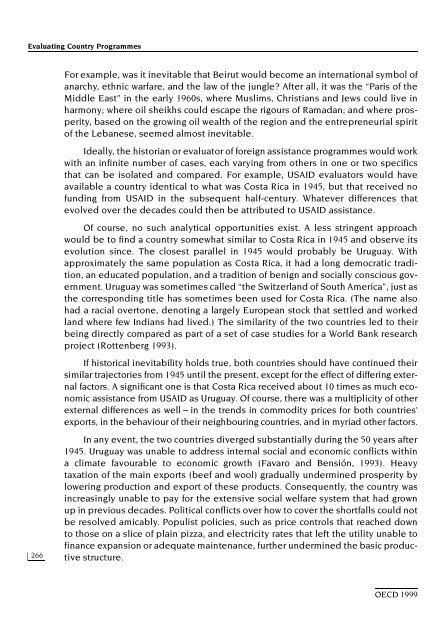Evaluating Country Programmes - OECD Online Bookshop
Evaluating Country Programmes - OECD Online Bookshop
Evaluating Country Programmes - OECD Online Bookshop
Create successful ePaper yourself
Turn your PDF publications into a flip-book with our unique Google optimized e-Paper software.
<strong>Evaluating</strong> <strong>Country</strong> <strong>Programmes</strong><br />
266<br />
For example, was it inevitable that Beirut would become an international symbol of<br />
anarchy, ethnic warfare, and the law of the jungle? After all, it was the “Paris of the<br />
Middle East” in the early 1960s, where Muslims, Christians and Jews could live in<br />
harmony; where oil sheikhs could escape the rigours of Ramadan; and where prosperity,<br />
based on the growing oil wealth of the region and the entrepreneurial spirit<br />
of the Lebanese, seemed almost inevitable.<br />
Ideally, the historian or evaluator of foreign assistance programmes would work<br />
with an infinite number of cases, each varying from others in one or two specifics<br />
that can be isolated and compared. For example, USAID evaluators would have<br />
available a country identical to what was Costa Rica in 1945, but that received no<br />
funding from USAID in the subsequent half-century. Whatever differences that<br />
evolved over the decades could then be attributed to USAID assistance.<br />
Of course, no such analytical opportunities exist. A less stringent approach<br />
would be to find a country somewhat similar to Costa Rica in 1945 and observe its<br />
evolution since. The closest parallel in 1945 would probably be Uruguay. With<br />
approximately the same population as Costa Rica, it had a long democratic tradition,<br />
an educated population, and a tradition of benign and socially conscious government.<br />
Uruguay was sometimes called “the Switzerland of South America”, just as<br />
the corresponding title has sometimes been used for Costa Rica. (The name also<br />
had a racial overtone, denoting a largely European stock that settled and worked<br />
land where few Indians had lived.) The similarity of the two countries led to their<br />
being directly compared as part of a set of case studies for a World Bank research<br />
project (Rottenberg 1993).<br />
If historical inevitability holds true, both countries should have continued their<br />
similar trajectories from 1945 until the present, except for the effect of differing external<br />
factors. A significant one is that Costa Rica received about 10 times as much economic<br />
assistance from USAID as Uruguay. Of course, there was a multiplicity of other<br />
external differences as well – in the trends in commodity prices for both countries’<br />
exports, in the behaviour of their neighbouring countries, and in myriad other factors.<br />
In any event, the two countries diverged substantially during the 50 years after<br />
1945. Uruguay was unable to address internal social and economic conflicts within<br />
a climate favourable to economic growth (Favaro and Bensión, 1993). Heavy<br />
taxation of the main exports (beef and wool) gradually undermined prosperity by<br />
lowering production and export of these products. Consequently, the country was<br />
increasingly unable to pay for the extensive social welfare system that had grown<br />
up in previous decades. Political conflicts over how to cover the shortfalls could not<br />
be resolved amicably. Populist policies, such as price controls that reached down<br />
to those on a slice of plain pizza, and electricity rates that left the utility unable to<br />
finance expansion or adequate maintenance, further undermined the basic productive<br />
structure.<br />
<strong>OECD</strong> 1999

















![CQE=U]^\]Z: KAZAKHSTAN - OECD Online Bookshop](https://img.yumpu.com/3915768/1/190x253/cqeuz-kazakhstan-oecd-online-bookshop.jpg?quality=85)